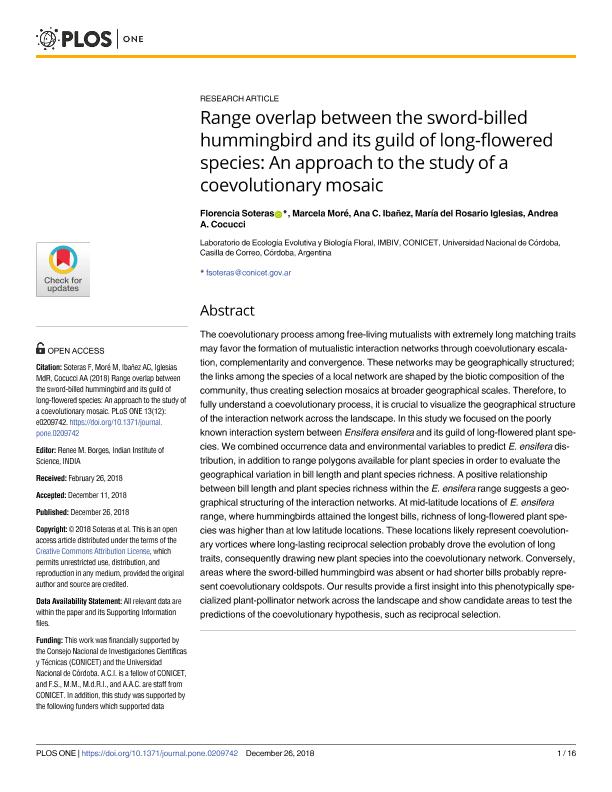Mostrar el registro sencillo del ítem
dc.contributor.author
Soteras, María Florencia

dc.contributor.author
Moré, Marcela
dc.contributor.author
Ibañez, Ana Clara

dc.contributor.author
Iglesias, María del Rosario

dc.contributor.author
Cocucci, Andrea Aristides

dc.date.available
2019-11-04T18:10:04Z
dc.date.issued
2018-12
dc.identifier.citation
Soteras, María Florencia; Moré, Marcela; Ibañez, Ana Clara; Iglesias, María del Rosario; Cocucci, Andrea Aristides; Range overlap between the sword-billed hummingbird and its guild of long-flowered species: An approach to the study of a coevolutionary mosaic; Public Library of Science; Plos One; 13; 12; 12-2018
dc.identifier.issn
1932-6203
dc.identifier.uri
http://hdl.handle.net/11336/87934
dc.description.abstract
The coevolutionary process among free-living mutualists with extremely long matching traits may favor the formation of mutualistic interaction networks through coevolutionary escalation, complementarity and convergence. These networks may be geographically structured; the links among the species of a local network are shaped by the biotic composition of the community, thus creating selection mosaics at broader geographical scales. Therefore, to fully understand a coevolutionary process, it is crucial to visualize the geographical structure of the interaction network across the landscape. In this study we focused on the poorly known interaction system between Ensifera ensifera and its guild of long-flowered plant species. We combined occurrence data and environmental variables to predict E. ensifera distribution, in addition to range polygons available for plant species in order to evaluate the geographical variation in bill length and plant species richness. A positive relationship between bill length and plant species richness within the E. ensifera range suggests a geographical structuring of the interaction networks. At mid-latitude locations of E. ensifera range, where hummingbirds attained the longest bills, richness of long-flowered plant species was higher than at low latitude locations. These locations likely represent coevolutionary vortices where long-lasting reciprocal selection probably drove the evolution of long traits, consequently drawing new plant species into the coevolutionary network. Conversely, areas where the sword-billed hummingbird was absent or had shorter bills probably represent coevolutionary coldspots. Our results provide a first insight into this phenotypically specialized plant-pollinator network across the landscape and show candidate areas to test the predictions of the coevolutionary hypothesis, such as reciprocal selection.
dc.format
application/pdf
dc.language.iso
eng
dc.publisher
Public Library of Science

dc.rights
info:eu-repo/semantics/openAccess
dc.rights.uri
https://creativecommons.org/licenses/by-nc-sa/2.5/ar/
dc.subject
ENVIRONMENTAL NICHE MODEL
dc.subject
GEOGRAPHIC MOSAIC
dc.subject
PLANT-POLLINATOR INTERACTION
dc.subject
SPECIALIZATION
dc.title
Range overlap between the sword-billed hummingbird and its guild of long-flowered species: An approach to the study of a coevolutionary mosaic
dc.type
info:eu-repo/semantics/article
dc.type
info:ar-repo/semantics/artículo
dc.type
info:eu-repo/semantics/publishedVersion
dc.date.updated
2019-10-24T18:18:47Z
dc.journal.volume
13
dc.journal.number
12
dc.journal.pais
Estados Unidos

dc.journal.ciudad
San Francisco
dc.description.fil
Fil: Soteras, María Florencia. Consejo Nacional de Investigaciones Científicas y Técnicas. Centro Científico Tecnológico Conicet - Córdoba. Instituto Multidisciplinario de Biología Vegetal. Universidad Nacional de Córdoba. Facultad de Ciencias Exactas Físicas y Naturales. Instituto Multidisciplinario de Biología Vegetal; Argentina
dc.description.fil
Fil: Moré, Marcela. Consejo Nacional de Investigaciones Científicas y Técnicas. Centro Científico Tecnológico Conicet - Córdoba. Instituto Multidisciplinario de Biología Vegetal. Universidad Nacional de Córdoba. Facultad de Ciencias Exactas Físicas y Naturales. Instituto Multidisciplinario de Biología Vegetal; Argentina
dc.description.fil
Fil: Ibañez, Ana Clara. Consejo Nacional de Investigaciones Científicas y Técnicas. Centro Científico Tecnológico Conicet - Córdoba. Instituto Multidisciplinario de Biología Vegetal. Universidad Nacional de Córdoba. Facultad de Ciencias Exactas Físicas y Naturales. Instituto Multidisciplinario de Biología Vegetal; Argentina
dc.description.fil
Fil: Iglesias, María del Rosario. Consejo Nacional de Investigaciones Científicas y Técnicas. Centro Científico Tecnológico Conicet - Córdoba. Instituto Multidisciplinario de Biología Vegetal. Universidad Nacional de Córdoba. Facultad de Ciencias Exactas Físicas y Naturales. Instituto Multidisciplinario de Biología Vegetal; Argentina
dc.description.fil
Fil: Cocucci, Andrea Aristides. Consejo Nacional de Investigaciones Científicas y Técnicas. Centro Científico Tecnológico Conicet - Córdoba. Instituto Multidisciplinario de Biología Vegetal. Universidad Nacional de Córdoba. Facultad de Ciencias Exactas Físicas y Naturales. Instituto Multidisciplinario de Biología Vegetal; Argentina
dc.journal.title
Plos One

dc.relation.alternativeid
info:eu-repo/semantics/altIdentifier/url/https://journals.plos.org/plosone/article?id=10.1371/journal.pone.0209742
dc.relation.alternativeid
info:eu-repo/semantics/altIdentifier/doi/https://doi.org/10.1371/journal.pone.0209742
Archivos asociados
